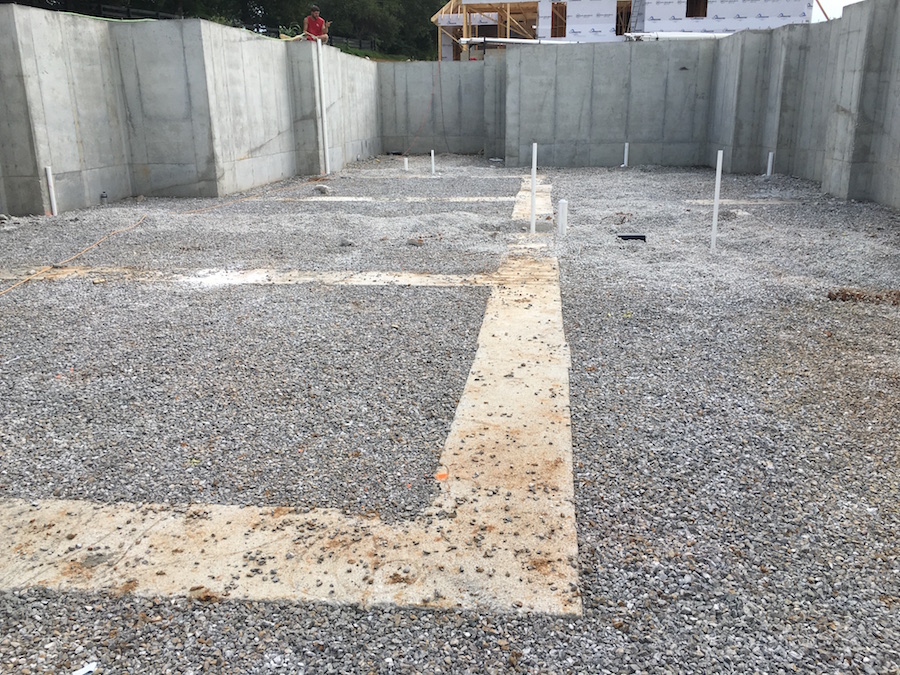
24 Oct Plumbing And Electrical Groundwork For Your Custom Home
Welcome to this edition of the Louisville Custom Home Builder Podcast Series, brought to you by Louisville’s leading luxury construction team, Artisan Signature Homes. I’m Greg, you’re host, and for today’s episode we are joined by Louisville’s best known, and most accomplished custom and luxury home builder, Jason Black. Jason, as always, nice to see you.
Jason: Greg, good morning, thanks for coming out today.
Greg: When we wrapped up one of our more recent podcast episodes about your 101 series of building a custom or luxury home, I think you talked about pouring footers, and the foundation of the house. You indicated that that was when plumbers might come in next. Am I remembering correctly?
Jason: Yeah, so once the foundation crew is done, and the exposed walls are left, it’s time for the plumbers to come in and we do what’s called the groundwork. There’s a couple things that takes place at this point in time. It’s important to think about where your bathroom is going to be, if you want a bar sink. Any type of drainage that would be necessary to have under the slab would take place at this time.
Greg: Are you talking about bathrooms in the basement, or bathrooms anywhere in the house? Anything that needs water anywhere?
Jason: It’s a couple facets of that. You definitely want to know where the bathrooms are in the basement, but we’ll also … Say you’ve got a 7 bedroom, or a 5 bedroom house, and you’ve got 2 bedrooms on 1 side, a couple bedrooms on the other side with bathrooms. We will put what are called plumbing stacks throughout the basement. We are planning the house from the ground up, so to speak, so yeah, we’ll have plumbing stacks, and drainage, all throughout the basement that will go under the slab, so it’s very important that we accommodate for that.
Greg: A plumbing stack would be … Is that just where you collect a lot of the water and the waste from several sources, into one larger-?
Jason: Yeah, so you’d have your waste water, you’d also have a vent to get the fumes out, out of the attic, so you get that smell out of the house.
Greg: You’re working off plans that are … Let’s say you’re doing a 2 story house with a basement. You have 3 levels of this kind of stuff that you have to know what you’re doing ahead of time so that you can plan, and then you mark that on the, as yet to be poured, basement floor?
Jason: That is correct, that’s correct. Yeah, sometimes people don’t understand that you’ve got to … Say they want to decide to add a bathroom over the garage, and they’re like, “Well what’s the big deal? We’re not even done plumbing yet.” Well, you go to find a way to get that water and waste from that bathroom over the garage, down into the basement, and out the sewer.
One of the other things that we do … We’re roughing in the plumbing, but we’re also at this point, we’re tying into the sewer, assuming you’re in a subdivision that has a sewer. We do a lot of work in the traditional neighborhood of Norton Commons, and we have sewers there. We’ll take all the plumbing, all the groundwork, through the basement, we’re under the basement slab at this point, and we’ll bore a hole underneath the footer or through the footer for the sewer line. We’ll connect everything inside, and then we’ll actually take that sewer line, and if all goes well, we will gravity feed it down to the sewer that’s 10, 12 feet below grade.
Greg: If all goes well, you gravity feed it. That just means that the sewer runs deeper under the street than we probably assume it does? That I assume it does?
Jason: Yeah, so one of the things we always want to make sure is that the sewer, we call, catches. What that means is that all the water, everything’s going to flow naturally downhill, down to the sewers. Worst case, if it doesn’t … What happens, if all your groundwork in the basement ends up being below … I guess it would be below the sewer line, and the sewer line is actually higher outside, so you actually have to pump the waste outside of the basement, up to the sewer. You’re pushing everything uphill so to speak. You can still gravity feed most of the plumbing from upstairs, not a problem, to the sewer, but a lot of times the basement bathroom sometimes doesn’t catch, and you have to put what’s called an ejector crock in there, that everything flows into that, and then you pump it upstream to the sewer.
Greg: How does that effect most of the homes that you’re building, since you’re strictly new construction? Is most everything nowadays above the sewer line, or do you still come across situations where you need that ejector crock?
Jason: Yeah, most of the homes in Norton Commons that we’re building, do catch. We do have occasionally some that … When you’ve got a couple thousand homes in a neighborhood, and you’ve got different sections, and everything’s trying to flow to one sewer, certain parts of the subdivision end up higher or lower than the others. It usually comes in the form of, you got to call the homeowner and say, “You know what? We didn’t catch, we’ve got to have the expense of an additional ejector crock to get that waste out of the basement.”
Greg: Okay. How does that actually work when you’re … If I remember correctly when you were talking about, you laid some gravel down, or some crushed rock, before you actually pour the basement. How do you mark for the plumber? Does the plumber just come and push the rock aside and get the plumbing stacks, the pipes that you see when you drive by?
Jason: Once the foundation crew leaves, there’s probably about a foot of rock, or gravel, or number 57’s, it’s a smaller stone, maybe a quarter size stone, something to give folks a perspective of what a 57 is. Sometimes we’ll use, they call them dime size, or 9, so they’re a little bit smaller as well. There’s different sizes of stones, but usually a smaller stone that compacts well. Then that’s all pretty level, and the plumbers will come in, they’ll spray-paint, we’ll mark up everything, and we’ll actually dig up everywhere the pipe is going to be. They’ll put all their pipes in, glue it all together, and then we’ll comeback in and cover it over with the rock.

Greg: I don’t know if this is a great question for a podcast, but I’ve always been curious, so I’m going to ask it. If you’re digging through rock, how does a plumber actually make sure that they’re connecting these pipe stubs that I see sticking up, into whatever needs to be connected to underneath all that rock? Does that even make sense?
Jason: Yeah, so we glue all of our fittings, and then once we’re done with all the rough plumbing, we will actually do a test. We actually get to test the … In Kentucky, the state of Kentucky comes out and tests to make sure everything passes. They’ll put smoke in there. We actually go through, and we fill everything with water, we do a water test, and we’ll make sure there’s no leaks coming out anywhere.
Greg: Okay, and is there any other trades, or anyone else who has to come in before you start … I don’t even know what comes next, pouring a basement floor, or putting walls up?
Jason: Yeah, so I’m going to back up just a second because there’s a couple things we still needed to … The plumbing is a pretty big aspect, and just don’t want to flush that down the toilet without finishing our conversation here.
Yeah, so that’s assuming … Norton Commons is on sewers, everything works fine. We’re doing some work in Anchorage right now, and we’ve got a custom home over in Beckley Crossing, right behind Valhalla Golf Course. We’re doing a septic system, so we’ve got to have lateral lines, and fields, and these are acreage lots that sewers just aren’t there yet, or haven’t come to this street, so we’ve got to dispose of that out in a field. Usually, in this case, the basements will almost never catch, so we have to pump the basements, and then we can gravity feed all the plumbing from upstairs. We take those through a pipe in the wall and we send them out to a field, and a tank, and then distribute it out there. All that, again, has to be accounted for prior to getting that basement floor ready for the next step of pouring the floor.
That’s a little bit about that. The other things we’ll do, we’ll bring in our water lines, so we’ll rough in our water lines, we’ll bring those in through the footer as well. That’ll be your main water line, we’ll put that usually in a mechanical room or somewhere easily to locate, where you’ll have your main water shutoff. Again, we’ll bury that water line underground and bring it underneath the slab.
Greg: At this point, are the utilities actually tied into the city services, so that the plumbing’s already tied in literally to the sewer, or does that come at the very end, and the water line, are they already tied in?
Jason: Usually at this point we’ll order our water meter as soon as we pull a permit. It usually takes our local water company anywhere from 4 to 8 weeks to get the water meter in. Usually we’re not tying in the water meter at this point, but we’re taking the water line, and we’re going to stub it up out by the street. When the water company does come in, they can put our meter in, and then we’ll have to come back and tie in to the meter. Usually we’re just roughing in, we’re roughing in the gas line as well at this point. That pretty much covers the plumbing aspect of underneath the slab, but like you said, sometimes there’s a need for electrical. Say you want to put a floor plug in the middle of your great room, this would be the time to put that floor plug in, under conduit, underneath the gravel before we pour that basement slab.
Greg: We keep coming back to planning, and coming back to another reason it’s good I’m not a builder. You’ve already thought about where all the outlets go. Is that something that you ask a client? Do they get input on where outlets go, or is it a standard formula that if the house is this big, and an outlet has to go here, here, and here?
Jason: Yeah, we’re going to ask. Usually outlets aren’t very common in the basement floor, so this is where it’s important. Sometimes people like theater seating that may have a plug in it to get that rumbling bass when the theater goes. The other time, if we’re putting a basement bar, we might have an island that’s going to need electric, so sometimes we can build columns out after the fact, to fish the electric down if we haven’t run electric. Or again, if we’re planning, we’ll go ahead and put conduit from the main bar, underneath where the island’s going to be for that electric.
We’ve also done some game rooms with Pac-Man machines, and pinballs, and all those that are center focused, and we’ll run the rough plumbing underneath the slab there as well.
Greg: It really sounds like planning is the name of the game, and that you have to get these people in before the next big step, and having it all thought of ahead of time is really key.
Jason: It is, the planning … A lot of people don’t realize all the effort that goes into getting a house. Sometimes they see it getting framed up and they’re like, “Oh look, that house just started.” Well, usually by the time we’re framing a house, we’ve been 6 months plus into the planning and construction of it.
Greg: Well you’ve said that several times and even after talking to you I’m still scratching my head of like, “I wonder what’s going on for 6 months.” You’re answering that.
Jason: Yeah, so we’ve talked about the rough plumbing, we’ve talked about the rough electric. Usually we wouldn’t have a need to put any heating and air, or anything in the floor unless we wanted a heated basement floor, now would be the time for that. One of the final things we would do prior to pouring a basement floor is a lot of times we’ll have steel beams and columns in the basement that’s going to hold up what will be the next phase of framing. We’ll actually get the framer in there, we’ll set the steel beams, set the posts, that way once we pour the concrete floor, we pour that and really solidify the steel into the house, with the concrete wrapped around the beam.
Greg: I hadn’t realized that. The posts that hold up the joists that go across the ceiling of the basement, those have the concrete poured around them to really make it all one piece?
Jason: Yeah, you can set those on top of the foundation and bolt them in, but we like to go ahead and just pour around it if we have our choice.
Greg: Okay. Very good. It sounds like we’re going to come back on the next episode and maybe talk about that next step which sounds like, I hope I’m right, pouring the basement floor?
Jason: Yep, pouring the basement floor and then moving on to one of the most exciting parts of the home building process, and that’s framing.
Greg: All right, I’m looking forward to it. Thanks for having me out.
Jason: All right Greg, take care.
Thank you for joining us on this episode of the Louisville Custom Home Builder Podcast. If you’re looking to build a home, and would like to reach out to Jason with any questions about the process, or maybe just your individual needs and desires, please visit the website at artisansignaturehomes.com. We appreciate your time with us today and look forward to bringing you another episode next week.



